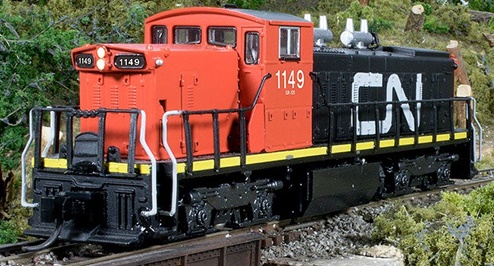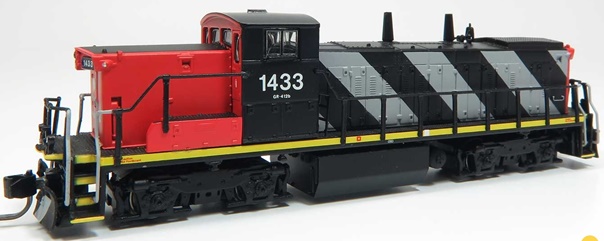

Introduced: 2015 (1000 Series) and 2019 (1100 Series, 1430-1444 Series, Cuban Variant)
This fine-looking and smooth-running model represents Rapido Trains' introduction into the N scale locomotive market. And despite a few first-time-at-bat QC "oopses" (more on that in a moment), it made for quite an impressive debut. Note that Rapido Trains (Canada) has absolutely nothing to do with the old Arnold-Rapido company of yore (nor the more recent Arnold-Hornby company). The shared names are purely coincidental.
These models all come with wired-up "dual mode" DCC decoders (with or without sound). IE, there is no "straight DC" option. The mechanism itself is quite a departure from the standard split-frame design that we're used to seeing from the likes of Atlas and Kato. As you can see, the chassis is one big hunk of metal that actually incorporates the sidesills, steps and pilots -

The small five-pole / skew-wound can motor employs dual flywheels. Pickup is provided by eight of the twelve wheels (by way of low-friction axle cups). The center wheelsets on each truck are electrically neutral. Wires soldered to the axle wipers transfer current to the decoder (two wires per truck). Bright white LED PC-boards mounted at either end of the chassis (and wired to the decoder) provide the directional lighting. Said lighting is kind of interesting insofar as it takes a moment for the light to reach full intensity (decoder-aided behavior, I'm sure).
As noted above, these models are available with DCC-sound (mine, pictured above, is so equipped). The speaker (and enclosure) is mounted to the front of the chassis (just behind the lightboard).

Plastic dogbone-style driveshafts engage the worm gears inside of the swiveling truck towers. Apart from the worms, all gearing is plastic. Only the outer two axles on each truck are geared. Wheels are blackened and low-profile (no problems on Code-55 rails). There are no traction tires. Couplers are chassis-mounted MT's.
These are finely detailed models with sharp paint and graphics. The fully-detailed cab is a very nice feature, and the under-chassis detailing is simply amazing (and definitely on a level never before attempted in N scale).

A little baggie of pre-painted detail parts (all-weather window, re-railers and sandbox fillers) is included in the box for those interested in making prototype-specific detailing changes to their models. Also included is a sheet of decals for those wishing to change the roadnumber (an inclusion that pretty much proves that the guys over at RT are hardcore model railroaders).
Performance is outstanding in every way. Mine runs extremely smoothly and quietly at all throttle levels (basically emitting no sound whatsoever with the DCC sound turned off). Slow speed creep is one-tie-at-a-time and the top end speed is quite realistic. Pulling power is strong, with mine able to comfortably haul thirty 40' freight cars through curves on level track (although any more than that and the wheels are slipping). I didn't have any problems with the wheels derailing (either through turnouts or on narrow radius curves), nor did I experience any pickup-related hiccups in performance. The DCC sound is, I guess, adequate. A bit thin and tinny sounding to my ear, but then again, about par for the course for N scale. Overall, these are terrific looking models that run every bit as good as they look. Definitely an auspicious debut for Rapido Trains.
OK, that said, there were a few QC issues with the first run of these models (although, to their credit, said issues were openly discussed and quickly addressed by the folks at Rapido) -
- The non-sound NAR and CN 1600-series locomotives run backwards when operated in DC mode (IE, put them on the track with a different engine and the two will run in opposite directions). To address this issue, RT offered straight DC (IE, no decoder) replacement chasses free of charge.
- On all non-sound locomotives, the headlights do not go on when operated in DC mode. The easy fix is to place the loco on a DCC layout and turn the headlights on (the headlights will work fine in DC mode from then on). For those without access to a DCC system, RT provided free Digitrax dummy plugs (thus allowing the locomotives to be operated without a decoder). This was a "do it yourself" solution on RT's part.
- Wheel gauge is a fraction of a millimeter too tight on many units (causing the locomotives to derail or jump on some turnouts). The drive wheels can be spread out manually, but if you go a fraction of a millimeter too wide, they will bind in the trucks. RT offered free replacement wheelsets to those experiencing these problems (again, another "do it yourself" project).
For more info on the above issues (and solutions), I suggest visiting the GMD-1 support website
As noted above, RT released a number of GMD-1 variants in 2019. AFAIK, the only changes were to the fuel tank and the trucks.



Prototype -
The GMD-1 was built between 1958 and 1960 by GM of London. It is an extended 1200 HP roadswitcher, eqully at home on the branchline, the mainline, and in the yard. Rapido Trains offers this N scale model in both the original 1000-series and the later rebuilt 1600-series versions. These were primarily designed for freight service, but did see some use with Steam Generator Cars when needed and pressed into passenger service. In 1988, CN remanufactured 15 GMD-1's in a major rebuild program. Among the external changes were the addition of anticlimbers, ditch light brackets, straight exhaust stacks in addition to internal mechanical upgrades. The new 1600-series units were called GMD-1A's. The GMD-1 was exclusively built for Canadian National and Northern Alberta Railways, and because of its unique appearance, quickly became a Canadian railway icon with a devoted following. They are still in service today.
Features -
- Factory-installed Digitrax DN136D dual mode decoder or ESU DC/DCC/SOUND LokSound decoder w/speaker
- Dummy plug included with non-sound models for optional straight DC operation
- Five-pole / skew-wound motor for excellent slow-speed performance
- Accurate dimensions from GMD blueprints and field measurements
- Heavy die-cast chassis for great pulling power
- Accurate 1000-series (6-axle) and 1600-series (rebuilt GMD-1A) variations
- A-1-A trucks with prototypically sized 40" and 33" wheels
- Full cab interior oriented the correct way (long hood forward for CN 1000-series, short hood forward for NAR and 1600-series)
- Body-mounted Micro-Trains couplers
- Up to six road numbers plus unnumbered for each paint scheme
- True GMD-1 sounds recorded from #1118 (formerly #1018) on the Alberta Prairie Railway
To remove the shell, first detach the handrail pins from the cab. Next, press in on the radiator screen on the long-hood end while pulling up. The locking tab at the end will come free, and the shell will start to come off. With a jeweller's slot screwdriver, carefully wedge the shell upwards along its length (starting at the front and working towards the back). Note - as you're lifting up on the shell, pay close attention to the etched metal steps on the either side of the cab. These are simply glued in place, and as such, are very fragile and easily dislodged.
Grade: A (with the above caveats re QC)